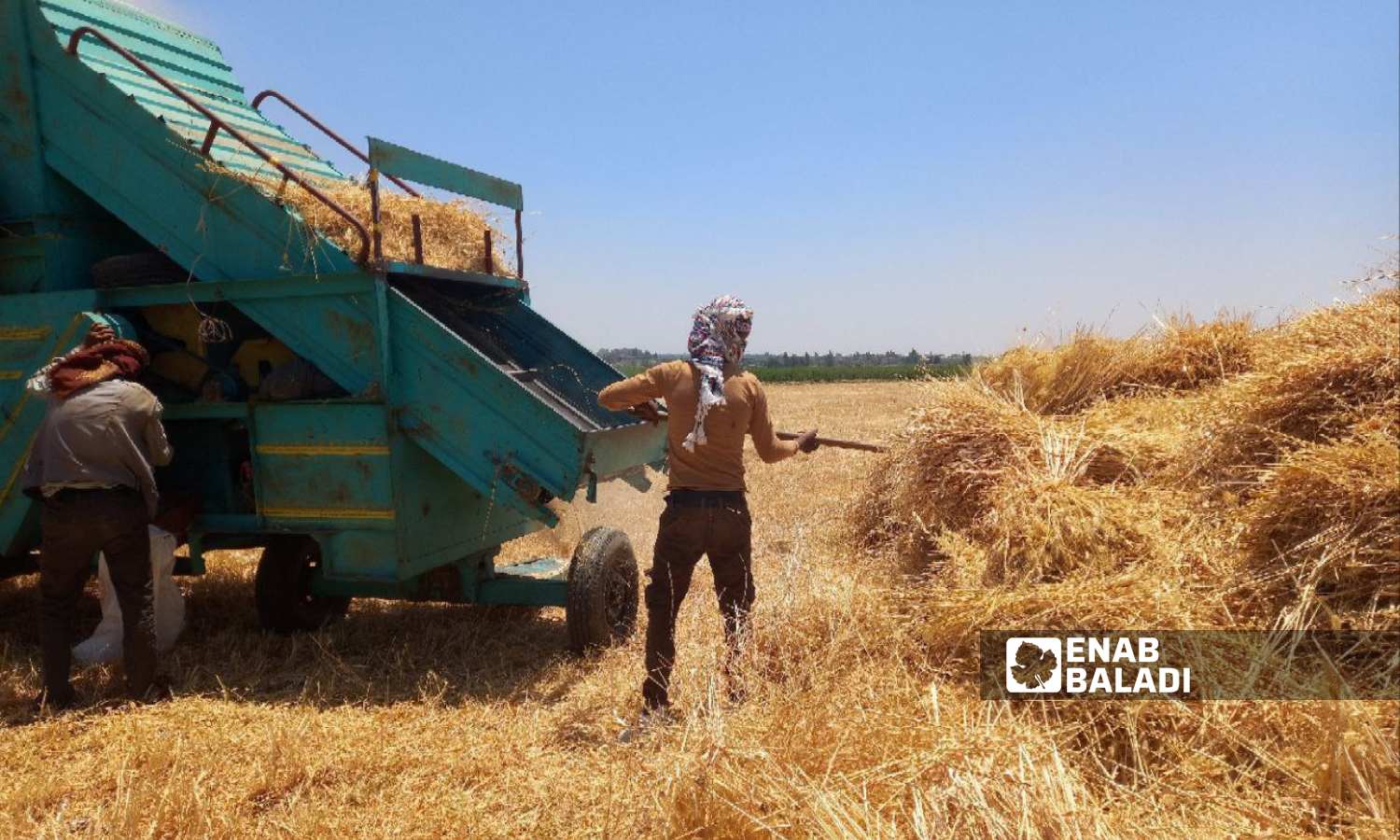



Owners of wheat harvesters in western rural Daraa are charging fees exceeding those set by the Executive Office of the Daraa Provincial Council, by more than 50% without government oversight.
Wheat farmers in western rural Daraa told Enab Baladi that they paid 125,000 Syrian pounds per dunam for the harvest, while the Executive Office of the Daraa Provincial Council, according to an official decision published by the Directorate of Agriculture on May 19, set the fee for harvesting a dunam of rain-fed wheat with straw at 80,000 Syrian pounds, and 70,000 Syrian pounds without straw.
The fee for harvesting a dunam of irrigated wheat was set at 95,000 Syrian pounds with straw and 85,000 Syrian pounds without straw.
The decision issued by the Directorate of Agriculture in Daraa set the fee for harvesting a dunam of barley at 65,000 Syrian pounds with straw and 55,000 Syrian pounds without straw.
Mohammad al-Salah (30 years old), a farmer from western rural Daraa who owns 50 dunams of rain-fed wheat, told Enab Baladi that he paid 125,000 Syrian pounds per dunam to the owner of the harvester he had contracted for his crop.
He added that he agreed to pay the amount due to fears of fires that frequently occur in the area, in addition to the scarcity of active harvesters in the region.
According to the farmer, the fees for mechanical harvesting are high, but they are less costly than manual harvesting, which costs 100,000 Syrian pounds per dunam for manual harvesting, plus the same amount for subsequent steps overseen by harvester workers to produce the crop.
The fires have prompted wheat and barley farmers to harvest their crops early for fear of repeated fires in the area, which could result in the loss of the entire season.
Farmer Abdul Rahman (55 years old) said he harvested his 20 dunams of wheat early this year out of fear of crop fires, resulting in him paying double the fees for the harvest.
Farmers along the Syrian-Jordanian border in Daraa province have resorted to harvesting their wheat and barley crops early since mid-May for fear of losing their agricultural crops to fires allegedly caused by the Jordanian border guards burning crops along the border to combat smuggling activities between the two countries.
This year’s spike in fires has prompted the Daraa Directorate of Agriculture, affiliated with the Syrian regime government, to open centers for early wheat delivery this year, as announced by the directorate on its official Facebook page on April 14.
Ziad, a harvester owner whose work is concentrated in western rural Daraa, told Enab Baladi that the increase in diesel prices has led harvester owners to raise their rates, as the Executive Office’s pricing is “unfair” in light of rising fuel prices.
The price of a liter of diesel reached 18,000 Syrian pounds at the beginning of June, while it did not exceed 13,000 Syrian pounds at the beginning of May.
The harvester owner added that his daily fuel requirement ranges between 150 to 200 liters, and there is no subsidized diesel allocation for harvesters from the Directorate of Fuel.
Harvesters also require mineral oils priced at 55,000 Syrian pounds per liter, as well as engine spare parts that have increased in price, coupled with maintenance fees. Each harvester needs a farming vehicle to accompany it for diesel and mineral oil refills or engine spare parts.
He noted that wheat production varies between western and eastern rural Daraa, as wheat in the western rural area is taller and denser on smaller-scale fields (tens of dunams), while field sizes in the eastern rural area reach hundreds of dunams, and the density and height of the wheat do not place a strain on the harvester.
Daily harvesting output in the eastern rural area reaches approximately 200 dunams, while it does not exceed 80 dunams in western rural Daraa in the best conditions, according to the harvester owner.
Furthermore, Ziad sees the price increase as not a significant issue, especially since the harvester operates only for two months a year and remains idle for ten months. With the rise in fuel prices and maintenance costs, it has become a loss-making venture for its owner.
According to the Director of Agriculture in Daraa, Bassam al-Hashish, the irrigated wheat areas planted in Daraa province exceed 11,000 hectares, and the rain-fed wheat areas amount to about 87,000 hectares, while the barley crop areas cover about 40,000 hectares.
if you think the article contain wrong information or you have additional details Send Correction